“Plans… are in full swing. We are designing a permit process that will allow not just restaurants but bars, retail, and personal service businesses to access the right-of-way.”
— Margaux Weeke, Commissioner Chloe Eudaly’s office
The food scene in Portland needs no introduction, but it does need more space.
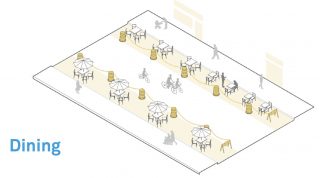
For restaurant, coffee shop and food cart owners to thrive they have to serve as many people as possible. Physical distancing limitations will make that difficult. As we move to the next phase of the Covid-19 era, Portland City Commissioner Chloe Eudaly wants to find more room for them to operate. Where’s she looking? In the street.
Next week, Commissioner Eudaly and the Portland Bureau of Transportation (which she oversees) will make an announcement about a new (and free) permitting process that will allow business owners to expand into the right-of-way. It will be the next step in the Slow Streets Safe Streets initiative that is slowly but surely transforming how Portlanders use and think about our streets.
“Plans for using the public right-of-way to expand outdoor dining for Portland’s restaurants are in full swing,” Eudaly’s Communications Director Margaux Weeke shared with BikePortland today. “Commissioner Eudaly is excited about the progress we have made on this initiative.”
And it won’t be just food and drink establishments. “Our plan considers open-air commerce as a whole,” Weeke continued. “Meaning we are designing a permit process that will allow not just restaurants but bars, retail, and personal service businesses to access the right-of-way.”
PBOT Planner Mauricio Leclerc hinted at the program at a meeting with the Hawthorne Boulevard Business Association yesterday. “As a bureau, we’re imagining, how does that work on a main street like Hawthorne?… You need a certain critical mass of customers to serve, but now you can only have half the crowd inside your restaurant. Can you sustain your business that way? Maybe you need the right-of-way for additional tables… We’re preparing a program to really help businesses get back to normal as quickly as possible using the right-of-way.”
Advertisement
“We need all the support we can get.”
— Chloe Eudaly, Portland City Commissioner
Portland is no stranger to eating in the street. PBOT launched the “street seats” program in 2012 and it was so warmly received they extended the program a year later. Then there’s the carfree block of SW Ankeny Street downtown. It was turned into a dining area in 2011.
This time around the changes are happening in a much different context. Climate change and congestion had already began to thaw long-frozen assumptions about streets. The pandemic has created a full-on melting.
Yesterday we reported that PBOT is seriously considering protected bike lanes on Hawthorne Boulevard, one of the most high-profile commercial main streets in Portland. The advocate who helped PBOT come around to that idea, Zach Katz, has also launched an effort dubbed Portland Promenade Project. That effort has a Facebook group with 72 members. One of them is Commissioner Eudaly, who’s right there in the trenches along other activists.
“I appreciate the initiative,” Eudaly posted in a recent comment on the Portland Promenades page. “We need all the support we can get.” Eudaly was responding to a rallying cry post from Katz. “Every restaurant I’ve talked to so far wants the whole street,” he proclaimed. “They don’t care about parking or congestion. For the first time ever, nearly 100% of businesses are fully in favor of pedestrianization.”
Eudaly wanted to make sure other activists realize: “There is a lot of opposition to closing streets in the larger community. Even the gentle reminder to not use Neighborhood Greenways [referring to the 100 “local access only” signs and barricades she ordered PBOT to install recently] is getting pushback.”
To avoid opposition to this business-in-the-street program (for lack of a better name), PBOT will have to rely on every innovative, outside-the-box muscle they have. Simply removing all the space we currently give away to free car parking would be an easy first step. But there are myriad complexities once you dig into the details. Leclerc said the effort, “Will be extremely context-sensitive to each area, maybe even to each block.”
Advertisement

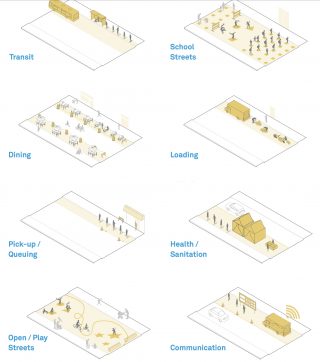
(Source: NACTO)
Thankfully the National Association of City Transportation Officials just released an impressive new resource that should give PBOT staff and the Commissioner’s office a roadmap (and a bit of political cover). NACTO’s Streets for Pandemic Response & Recovery (PDF) includes a section on in-street dining areas. They recommend that cities, “Identify restaurant clusters and designate ‘dining street’ zones,” “waive existing permit fees for outdoor dining within preselected zones,” and “establish clear occupancy standards (e.g. table counts) for ‘dining street’ zones.”
Portland will also have to make sure these dining zones don’t privatize public space. One of the drawbacks of Ankeny Alley is that restaurant owners roped off most of the street and left only a few feet for the public to walk through.
The timing of Eudaly’s initiative is also fortuitous because the all-powerful Oregon Liquor Control Commission just announced they’ll fast-track applications for restaurant and bars to sell alcohol on sidewalks and streets.
If momentum holds, calmer streets with more people, fewer cars, and relaxed drinking regulations could be in place just as evenings start to warm up and safer virus precautions are the norm.
At the meeting yesterday, PBOT’s Leclerc said small businesses and restaurants are the “the jewels to the city” and they need more space to shine. As for the street dining program he’s working on. “I think we have something very special going on,” he added.
Stay tuned!
UPDATE, 5:22pm: PBOT will call this effort “Healthy Businesses”. A planner shared more details in a meeting of the PBOT Bureau Budget Advisory Committee today. We’ll have an update Friday morning.
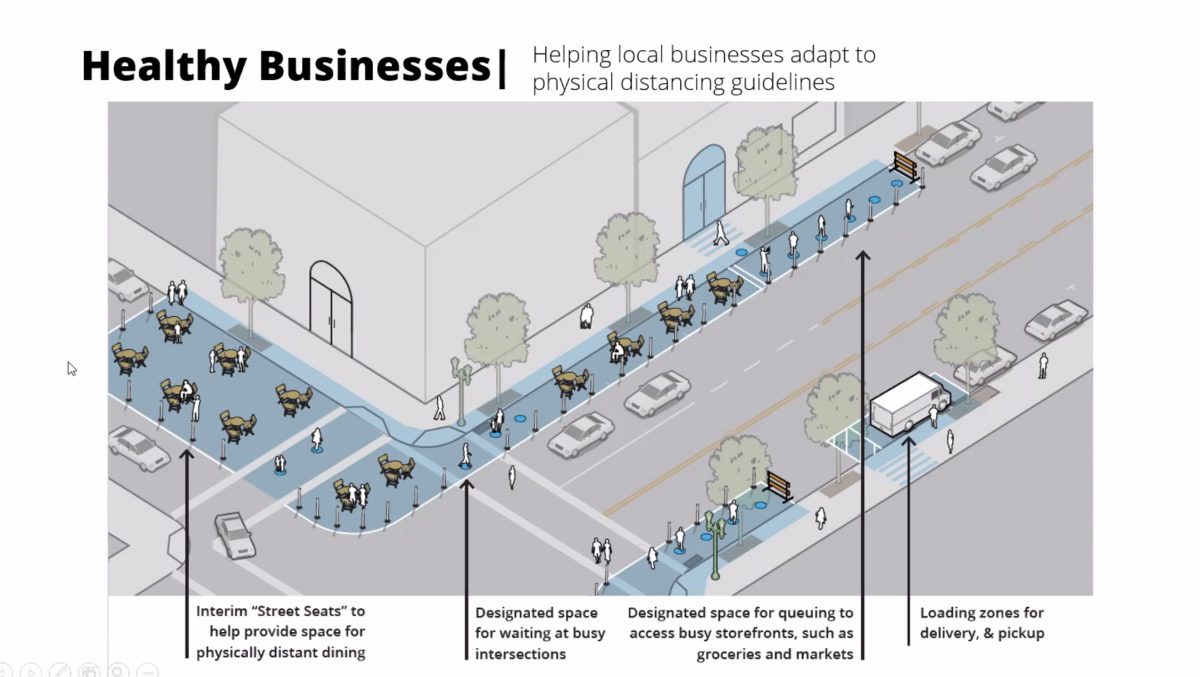
— Jonathan Maus: (503) 706-8804, @jonathan_maus on Twitter and jonathan@bikeportland.org
— Get our headlines delivered to your inbox.
— Support this independent community media outlet with a one-time contribution or monthly subscription.



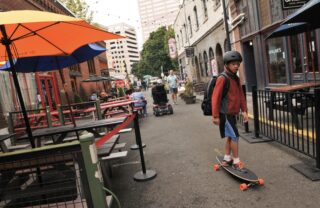
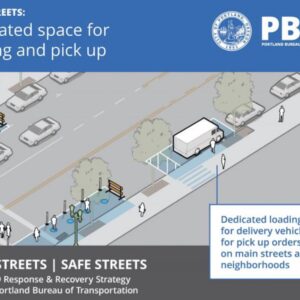
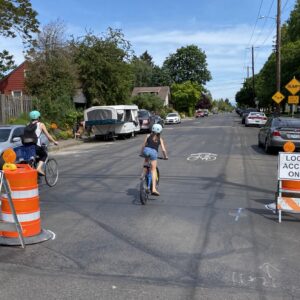

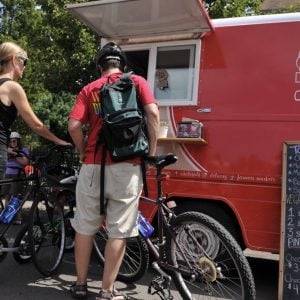
Thanks for reading.
BikePortland has served this community with independent community journalism since 2005. We rely on subscriptions from readers like you to survive. Your financial support is vital in keeping this valuable resource alive and well.
Please subscribe today to strengthen and expand our work.
Where?
Nowhere yet. Hasn’t even been launched yet! When it does, PBOT will consider on a case-by-case basis.
UPDATE, 5:22pm: PBOT will call this effort “Healthy Businesses”. A planner shared more details in a meeting of the PBOT Bureau Budget Advisory Committee today. Update coming Friday morning.
I think the only reason she is even talking about this is because of the election. I’m betting that the 65% people that didn’t vote for her during the primary are going to continue voting for anyone else but her. She has made it clear that she doesn’t care about things like this and it will drop the idea the second no one is looking.
It’s like she suddenly remembered she was head of PBOT six months ago. Her mailers didn’t have a single tangible achievement on the roads.
The best thing she can do for Portland is spend her remaining months laying the groundwork for someone else.
And keep scooters off the sidewalks for the last few months of her term
Maybe the reason she’s talking about it is, this happens to be a time when a major sector of the local economy has taken a 70? 90? % hit and jobs / whole businesses are going away if something isn’t done? CE ran a small business for years. She gets it.
Could the Chloe haters take a day off once in a while?
People who don’t support her re-election are not all “haters.” She has a record, and in a democracy we are free to agree with what she’s done, or express disagreement.
For me, I look at her record on reducing traffic fatalities and injuries, enhancing bicycle safety through significant infrastructure improvements, promoting e-scooters while while addressing significant safety issues- including that relative to pedestrians on the sidewalks, etc., see failure, and have decided we need a change.
Vancouver is looking into something similar. Businesses will be able to apply to have parking spots converted to seating or waiting areas. There is already sidewalk seating available for most restaurants. Like the idea but not sure how pedestrians will socially distance in the narrow space left to them.
I could see this happening first around the food trucks downtown and in inner Portland, as well as at the fast food and sit-down chains in outer Portland. On the breathtakingly-wide streets of DC with their 20-40 foot wide sidewalks, the main owners of cafe outdoor seating are chiefly chain restaurants rather than the local businesses, probably for liability reasons, permit costs and greater risk-taking for vandalism. I’m not sure how well this is going to work on the little narrow streets of inner Portland like SW 4th, Mississippi, Broadway, or Hawthorne, but I’m sure someone will try it. I can pretty easily imagine McDonald’s trying it at 102nd & Weidler, a pretty busy location.
I don’t see it happening with any concept of social distancing in mind – not on our sidewalks.
You don’t need a wide street or even wide sidewalks to do outdoor dining. This street in Vienna, as a random example, is roughly 40′ wide and narrower than any of the Portland streets you describe. We already have a street seats program in Portland, with examples on NE Alberta, for instance. It’s just been pretty limited to-date.
As I recall from having passed through many similar set ups both throughout Europe and in many communities in the USA, one also had to go through a gauntlet of cigarette smoke, waiting staff, and patrons sitting every which way, often blocking that 4 foot wide corridor. There’s basically no space for 6-foot social distancing in such a set up.
You can design to create more physical distancing using the additional room outdoor space provides. Part of the point of this is to give people more space to spread out, compared to the confined space of a small restaurant, cafe, or shop. Done the right way in the context of COVID, they won’t be the same as the crowded sidewalk café’s you might associate with Paris or Vienna.
Is there any word on how the city and owners are going to be handling panhandlers, utility-cutters, and petition-seekers in what is still public right-of-way at or within sound distance of these locations?
This ties into questions of privatizing public space — if businesses have some sort of claim on a spot, and can chase away “undesirables” (which might be construed as non-customers), is that space still “public”?
I’d absolutely sign a petition to keep petitioners 100′ away from store entrances.
Truly another ridiculous thing in a long line of ridiculous things the Portland has done.
I think this is a great move. It’s about time we start using street space for more community functions, and I hope this doesn’t end with the COVID recovery. Using street space for commerce and gathering is as old as cities themselves. On corridors, this doesn’t have to be just on the corridor, in Hawthorne you could close a cross street like SE 37th off (where the Bagdad Theatre is) and repurpose it as a street market. Not really a radical thing. Let’s do it!
Not sure it would be as great for restaurants as it sounds. Perhaps it would work well in sunny California, or maybe for a few months during the Summer, but there are many cold/wet months. Even in the Spring when it starts to get warmer, the rain can be quite unpredictable. If a restaurant has to rely on the weather to determine whether it’s worth opening for the day or not, that will make it very difficult to recoup costs for a business model with already very thin margins and difficult for hourly/tipped employees who need a stable source of income.
This is great news…to recalibrate the value of public street space higher than “storage of personal” vehicles. The critical balancing act will be seeing how many tables a business will need to be viable than calculate the socially distant space for each table. A standard car stall is barely large enough for three cafe tables and buffer space…thus the efforts in many cities soon found that this calculation caused them to rethink and look to the rest of the street space set aside for vehicle movement.
The other important calculation is setting up the rules and the required “equipment” so that it can be enforceable AND affordable as a warm weather pilot project. Requiring cafe decks / platforms and railings would soon tax any struggling business’ post COVID19 pocket book.
Bike Portland has a reference to a relevant article in today’s Monday Roundup.
https://www.curbed.com/2020/5/20/21263319/coronavirus-future-city-urban-covid-19
Coronavirus is not fuel for urbanist fantasies
“Even before the staggering impact of the novel coronavirus had been fully revealed, the people who write and think about cities were busy writing prescriptions for their recovery. But instead of bearing witness to mass death as a moment of reflection, many urban advocates are using the coronavirus as an opportunity to accelerate their pre-pandemic agendas—agendas which ignore the issues that made COVID-19 more catastrophic than it should have been…..
“If the coronavirus has made anything clear, it’s that cities cannot be fixed if we do not insist on dismantling the racial, economic, and environmental inequities that have made the pandemic deadlier for low-income and nonwhite residents. Yet many prominent urbanists have simply tweaked the language from their January 2020 tweets and fed them back into the propaganda machine to crank out COVID-tagged content, perpetuating the delusion that all cities need are denser neighborhoods, more parks, and open streets to magically become “fairer.”
Does this sound familiar?